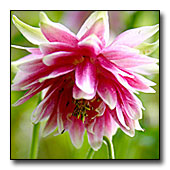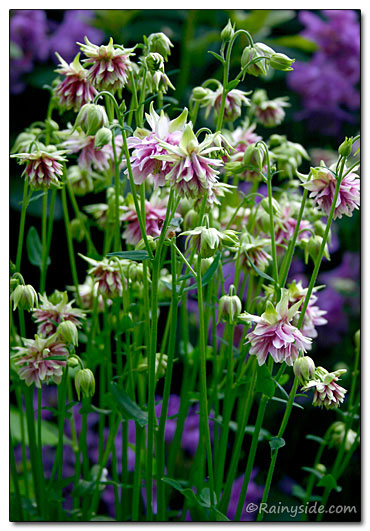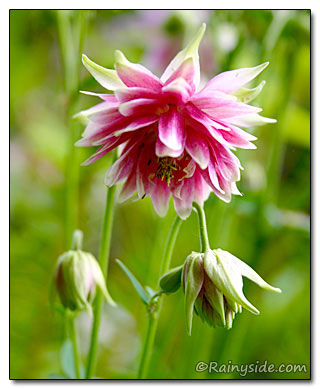Aquilegia vulgaris 'Nora Barlow'
COLUMBINE
Family: Ranunculaceae
Pronounced: ack-wi-LEE-gee-uh vul-GAR-iss

Quick Jumps
Growing Guide
Rainy Side Notes
GROWING GUIDE

Origin:
Garden.
Plant Group:
Perennial.
Hardiness:
Sunset zones: A2, A3, 1-10, 14-24.
USDA zones: 3-8.
Heat zones: 8-1.
Mature size:
Height: 36 inches (90 cm).
Width: 18 inches (45 cm).
Flowering period:
Late spring to early summer.
Flowering attributes:
Five to fifteen pendant, spurless, flowers on racemes. Tepals are pinkish red to pale green.
Leaf attributes:
Mid-green, two ternate leaves with lobed leaflets.
Light:
Full sun to partial shade.
Soil:
Fertile, moist, well-drained soil.
Feeding:
Add a complete organic fertilizer when planting and in spring when new growth begins.
Propagation Methods:
Sow seed in containers as soon as ripe. Place in cold frame for winter.
Pruning Methods:
Dead head spent flowers to prolong bloom. When the flush of flowers are over, cut the plants down to the ground to rejuvenate them. The columbine's new growth is fresh and green the rest of the season.
Pests and Diseases:
Powdery mildew and rust may be problems during dry summers. Caterpillars, aphids and leaf miners can also be problems. In spring, leaf miners tunnel through the surface of the leaves, leaving unsightly foliage. To remedy this, cut the whole plant down to the ground after they finish flowering. The leaf miner larvae are gone by the time the second new growth begins.
Rainy Side Notes

Spurless, double pink to green flowers are a trademark of Aquilegia 'Nora Barlow', a mutant vulgaris form, cultivated for over two hundred years. It appears that many gardeners love the blossoms, while some noisily declare hatred for them. In the year 2000, Christopher Lloyd wrote, "It is an ugly flower, but different." Lloyd always had strong opinions to share, and many times I disagree with his assessments. Although the flowers are different, ugly is too strong to describe the quiet, interesting flowers. Then along comes Robert Nold, author of COLUMBINES Aquilegia, Paraquilegia and Semiaquilegia, who writes, "Or, it looks somewhat like a columbine that stuck its finger into an electrical outlet by mistake."
Maybe I have a soft spot in my heart for mutant underdogs. I grew the plants from seed harvested from the garden of a family member. When the columbines were large enough, I nestled them into a partially shaded area amongst ferns and rhododendrons. At first glimpse of the newly opened flowers, I too was disappointed. Slowly I changed my mind. The garden looked rather lovely with the addition of the subdued colors of the columbine's blossoms; they blended well with the woodland-like scene. I recommend them for a cutting garden, because the racemes full of flowers make voluminous filler for a vase.
Photographed in author's garden.
A Pacific Northwest Plant of the Week (2013)
Additional Reading
COLUMBINES Aquilegia, Paraquilegia and Semiaquilegia by Robert Nold.
Christopher Lloyd's Garden Flowers: Perennials, Bulbs, Grasses, Ferns by Christopher Lloyd.

Gardening for the Homebrewer: Grow and Process Plants for Making Beer, Wine, Gruit, Cider, Perry, and More
By co-authors Debbie Teashon (Rainy Side Gardeners) and Wendy Tweton
Copyright Notice | Home | Search | Perennials

